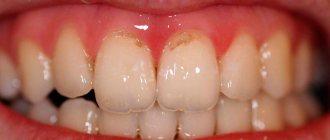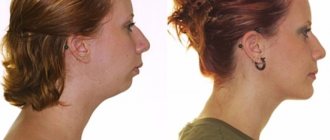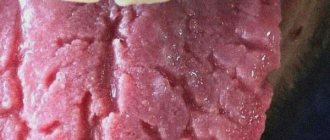What to do if your child has a pink tooth
The tooth consists of both hard and soft tissues. Inside it is soft pulp and nerves. The pulp is made up of a semi-solid material called dentin. Dentin helps form the bulk of the structure and protect the sensory nerves and blood vessels inside. Enamel is a thin coating over dentin that adds another layer of protection. Enamel helps protect dentin and pulp from bacteria. Caries that gets into the enamel and dentin and reaches the pulp can lead to its death. When decay reaches the pulp, it creates a pathway for bacteria to infect the tissue. A healthy pulp will respond to infection the same way as any other part of the body: with inflammation.
Another thing that can cause redness is injury. If you are struck in the jaw by a fall or while playing sports, it can damage blood vessels. The tooth needs blood, so when there is no more blood, it dies. This usually happens slowly over time and does not cause as much pain as when decay reaches the pulp.
During eruption, root resorption occurs. The root is absorbed and begins to dissolve. Once the root is completely resorbed, the baby tooth will fall out - so there will be no visible root. If resorption continues, a pink tint may appear. It may take about 2-3 weeks for the color to change. If the tooth turns red, this is the result of thinning or translucency of the enamel. This looks strange, but is not a cause for alarm. Parents can always consult a dentist if the child is bothered by pain or the shade becomes more intense.
The damage is usually irreversible, but sometimes it can be repaired, especially if it is caused by tooth decay. The dentist will make a diagnosis and recommend treatment.
Abnormalities in tooth color
Let's be honest - a smile has a powerful communicative effect.
Therefore, aesthetic dentistry is developing at a rapid pace. Thanks to this, most people can have white, healthy teeth.
Let's close our eyes and imagine Julia Roberts for a minute. I bet everyone remembered the image where the actress smiles with her wide, snow-white smile, which immediately captivates the viewer.
In this article we will look at what is normal teeth color and what is a deviation from the norm, and most importantly, what to do and where to go.
1. Brown plaque. Reasons: most often these are tannin deposits from tea, coffee and other food colorings.
Solution: professional oral hygiene at the dentist and correction of manual skills when brushing teeth at home
2. Darker brown color. Reasons: such plaque occurs in smokers due to the penetration of tobacco tar into the tooth
Solution: professional oral hygiene, correction of home care, if this does not help, then you still have to quit smoking.
3. Black plaque in the neck of the tooth. Priestley's raid. Cause: Associated with color-producing bacteria, which form a dense coating of brown or black color. More common in children.
Solution: such plaque very quickly recurs again, almost immediately after professional oral hygiene. It is necessary to add a paste with enzymes, for example, from the Curaprox Enzical line, to your daily hygiene.
4. Green and orange plaque Cause: the relationship between poor oral hygiene and certain bacteria.
Solution: correction of oral hygiene, professional oral hygiene, correction of general somatic health.
5. Discoloration caused by antiseptics Reason: often long-term exposure to chlorhexidine as a result of which we get a gray coating.
Solution: do not prescribe antiseptic treatment for yourself, follow the recommendations of your dentist. Remove plaque using professional oral hygiene, eliminate antiseptics.
Next, we will look at dental discolorations associated with the penetration of dye into the tooth.
6. Fluorous teeth Cause: increased fluoride content in drinking water. It is an endemic disease.
Solution: depends on the severity of the lesion. Sometimes microabrasion and tooth restoration using filling material helps. In difficult cases - only prosthetics. The disease requires mandatory monitoring and observation by a dentist.
7. Tetracycline teeth Reason: taking tetracycline antibiotics at the time of formation of the rudiments of permanent teeth. Teeth are most susceptible to this antibiotic between the second trimester of fetal development and up to 8 years of age.
Solution: it is possible to completely remove the yellowish plaque only after prosthetics
8. Change in tooth color after root canal treatment Reason: there may be several, more often it is the remaining bacteria inside the tooth that stains the enamel and dentin black/brown/dark brown. It is possible to fill the root canal with resorcinol-formalin, then the tooth acquires a color from pink to dark purple.
Solution: mechanical and medicinal cleaning of the root canals is necessary, followed by tooth prosthetics.
9. Grayish-black color due to amalgam fillings Cause: Silver sulfide stains the walls of the tooth a dark gray color.
Solution: replacement of the filling, possible prosthetics.
10. Enamel hypoplasia Causes: many from nutritional deficiency to the influence of viral infections. Solution: depends on the severity of the lesion. Sometimes you can get by with additional home care, in other cases only prosthetics.
We have examined only some of the dental discororites that are more common in practice and in life. Treatment is always complex. This includes professional oral hygiene plus correction of home hygiene, possibly in-office whitening, and in difficult cases, prosthetics and consultation with third-party doctors such as a therapist, endocrinologist, gastroenterologist, etc.
In any case, anyone who wants to have a white, healthy smile can do so thanks to modern dentistry.
How to treat a pink tooth in a child
A pink tooth in a child should not cause panic. It is important to know that this is usually not a serious situation. The problem often occurs in young children and, as a rule, it is harmless - there is no harmful effect on the health of the jaw. A red tooth in a child is a sign of resorption.
If the pink discoloration is persistent, it may indicate a more serious problem and parents should consult a dentist.
The doctor can:
- put a seal;
- remove dentin;
- apply intracanal bleaching.
Treatment depends on various factors and the exact cause of the change in shade.
Is caries treated in baby teeth?
Is it necessary to treat caries on baby teeth? This question still remains open for some parents. Even knowing that the child has caries, they are in no hurry to see a doctor, thinking as follows: “the milk teeth will fall out anyway.” Such judgments are absurd, because infected baby teeth will lead to complications in the growth of permanent teeth or provoke an exacerbation of other diseases in the baby’s body. One way or another, you will have to remove the baby tooth ahead of time. Caries in pediatric dentistry is considered one of the most common diseases, so both parents and specialists should ask the question “why is it necessary to treat caries of primary teeth?” Dentists believe that treatment of caries in a baby tooth will preserve it until the “arrival” of the molars.
What to do if an adult’s tooth turns red
As resorption occurs, the pink or red color becomes more noticeable and the structure changes. If you catch the early stage of dying, there is a chance to preserve the external structure. The internal, damaged pulp can be cleaned out and replaced with a hard filling material that will help protect the structural integrity. Preserving as much of the original structure as possible is important for oral health. Gaps in your smile can lead to poor jawbone health, uneven bites, bacterial growth, and cosmetic problems.
If severe damage is observed, removal will likely be the best option. It is recommended to get an implant to maintain the health of your jaw and mouth.
University
Teeth have many shades. The individual natural color of teeth is determined by dentin, but is influenced by the color, transparency, thickness and degree of mineralization of the enamel. The blue or pink tint of the enamel is complemented by the color of the dentin, which varies from yellow to brown. This is how different color variants of the norm are formed.
Over time, the color of teeth can change as a result of external or internal staining. External action occurs during the local influence of a number of factors on tooth tissue, while chromogens (compounds that include pigments) are located on its surface. Internal color change is associated with the process of systemic exposure to the body; chromogens are located in the tooth tissues (usually in dentin). Dentists also identify internalized discoloration (as a result of chromogens entering the tooth through cracks and chips).
Features of external color change
External color change is divided into direct and indirect coloration. Direct staining occurs as a result of the penetration of chromogens into the pellicle of the tooth, which leads to a change in the basic color. Indirect staining occurs due to the chemical interaction of various compounds on the surface of the tooth.
Direct coloring. Color-changing chromogens are found in many foods (tea, coffee, spices, vegetables, red wine). Tobacco and many medications also cause staining of teeth. The chromogen penetrates into the pellicle, which absorbs and retains dyes like a sponge. Chromogenic bacteria have been identified that are responsible for green or orange staining of teeth in children (due to poor oral hygiene).
Indirect staining. Associated with cationic antiseptics and metal salts, which are either colorless or give color as a result of chemical interaction with other compounds. For example, blackening of enamel in those taking iron supplements; green discoloration resulting from the use of mouthwash solutions containing copper salts; purple-black coloration that occurs when using mouthwash solutions containing potassium permanganate.
Causes of internal discoloration of teeth
Metabolic. Metabolic disorders (alkaptonuria, congenital erythropoietin porphyria and hyperbilirubinemia) cause discoloration of teeth. Alkaptonuria is an inborn error of metabolism accompanied by discoloration of teeth (brown color). Congenital erythropoietin porphyria is a rare recessive autosomal metabolic disorder that causes a red-brown color to the hard tissues of teeth. Congenital hyperbilirubinemia is characterized by a yellow-green discoloration caused by the deposition of bile pigment in the mineralizing hard tissues of the tooth, especially in the neonatal line, as a result of massive hemolysis due to Rh incompatibility.
Hereditary. Amelogenesis imperfecta is an inherited condition in which enamel formation is impaired. The appearance of the teeth is greatly changed: the enamel is hypoplastic, thin, yellow to brown in color, and may be hypomineralized (depending on the type of amelogenesis imperfecta). It is assumed that the color of the teeth reflects the degree of enamel hypomineralization: the darker it is, the more severe the degree of this condition.
Dentinogenesis imperfecta is a hereditary disorder of dentin. Dentinogenesis imperfecta type 1 is associated with osteogenesis imperfecta (a mixed disorder of type 1 collagen connective tissue). Characterized by the opalescent color of primary teeth, especially if this condition is the result of dominant inheritance.
Type 2 dentinogenesis imperfecta may be more severe in primary teeth than in permanent teeth. The pulp chambers of the teeth become obliterated. When the enamel is chipped, dentin wears out quickly. The clinical appearance (amber, gray, purplish-blue, or opalescent color) is considered to be the result of absorption of chromogens into porous dentin after dentin is exposed.
Dentinogenesis imperfecta type 3 is similar to the first two types of dentinogenesis imperfecta, characterized by multiple pulp exposures in primary teeth.
Researchers note that primary and permanent teeth with type 1 dentin dysplasia have normal outlines and shapes, but are amber-colored. The pulp chambers in primary teeth are often obliterated, while in permanent teeth only crescent-shaped processes of the pulp parallel to the enamel-dentin junction are revealed. With type 2 dentin dysplasia, the teeth are brown and the pulp chambers are affected with the formation of denticles.
Iatrogenic. Tetracycline staining occurs as a result of systemic use of tetracycline. Pregnant and lactating women and children under 12 years of age should avoid taking the drug. The color change depends on the dosage, duration of use, and the age of the patient at the time of prescription. Some authors note a decrease in color intensity over time, explaining this by photo-oxidation under the influence of light. Tetracycline analogues cause various color changes, for example, chlortetracycline is a bluish-gray tint, oxytetracycline is creamy.
Tetracycline discoloration is classified according to the extent, extent, and location of the lesion.
Fluorosis can result from high levels of fluoride in drinking water or from the use of fluoride mouthwashes and toothpastes. This type of discoloration is more common in enamel, ranging from speckles to a diffuse opaque spot appearing on a chalky white or brownish-black background.
Traumatic. The cause of tooth discoloration is the bleeding products of the pulp formed as a result of trauma. Hemoglobin molecules accumulate in an injured tooth; when they break down, iron ions are released, which, when bound with oxygen, form iron oxide. The oxides can then combine with sulfur to form dark gray iron sulfide. Penetration into dentin determines the intensity of the color change.
Root resorption due to dental trauma often presents as a pink, punctate lesion at the enamel-cementum junction, with no other symptoms. Resorption always begins on the root surface and can be internal or external.
Enamel hypoplasia of permanent teeth occurs as a result of damage to the tooth germ of a developing tooth due to trauma or infection of primary teeth, which causes a local enamel defect (postnatal discoloration). The formation of depressions or grooves promotes further internalization of external chromogens.
Dentin hypercalcification can occur following trauma. Temporary disruption of the blood supply to the tooth and damage to the odontoblasts causes excessive, irregular deposition of dentin in the pulp chamber and the walls of the root canal. The tooth gradually loses its transparency and becomes yellow or yellow-brown.
Idiopathic. Molar-incisal hypomineralization (MIH) is a condition of unknown etiology characterized by significantly hypomineralized enamel affecting the incisors and first permanent molars. Enamel hypomineralization occurs asymmetrically, affecting one molar and leaving the opposing molar relatively intact or with minimal subsurface defects. Enamel defects can range from white to yellow or brownish areas. The border between healthy and damaged enamel is always clearly visible.
Currently, possible etiological factors for MGD include infections in early childhood, dioxin in breast milk, and genetic factors.
Age. The enamel undergoes thinning and structural changes, and the deposition of secondary, tertiary dentin and denticles contributes to darkening during the aging process.
Internalized color change
Dyes penetrate into the hard tissues of the tooth through developmental defects or acquired defects as a result of diseases of the hard tissues. The penetration of a dye into the porous structures of a tooth with developmental defects often changes the color of an already stained tooth.
Acquired defects arising due to caries or inadequate quality of restoration materials can lead to discoloration.
• Abrasion, erosion of teeth. As a result of these processes, dyes affect dentin. When enamel is lost and dentin is exposed, teeth appear darker (as the color of the dentin becomes more visible).
• Gum recession. The exposure of dentin makes the teeth more susceptible to the internalization of stains.
• Caries. Accompanied by blackening of the tooth.
• Restoration materials. The gray-black discoloration seen around old amalgam fillings is caused by the migration of tin into the dentinal tubules.
• Endodontic treatment. Preparations containing eugenol give the tooth an orange-yellow tint when the root canal mouth is not properly sealed. Silver posts in root canals give the tooth a gray-black hue due to oxidation.
Solving aesthetic problems associated with tooth discoloration is one of the actively developing areas of dentistry.
The methods are varied and numerous. The modern approach includes the combined use of different techniques, which gives the most effective results. Elena Mirnaya, Associate Professor of the 2nd Department of Therapeutic Dentistry of Belarusian State Medical University, Candidate of Medical Sciences. Sciences Photo: Anna Bergman Medical Bulletin , June 13, 2022
Why does a filled tooth suddenly turn pink?
If dental treatment was successful, but the healed tooth hurts, this does not indicate any problems, but gives reason to consult a dentist. If the filled tooth turns pink, this may be the result of the fact that the paste contained resorcinol and formaldehyde. But most often the change signals pulpitis, periodontitis, traumatic injury or rupture of a vessel in the pulp.
If a tooth turns red, you should immediately contact your dentist to get a diagnosis. A potential infection should not be left unattended; it is important to ask what treatment options are available and make an informed decision.
Treatment of caries of primary teeth in children
If the doctor finds that a child has incipient caries, then most likely, treatment of baby teeth will not be required. The specialist will protect the enamel from further destruction using a painless and effective procedure - applying fluoride varnish or a silver fluoride compound. Then, when the baby gets permanent teeth, the dentist can seal the fissures - the depressions between the elevations of the tooth - which will prevent the occurrence of bacterial plaque that destroys the enamel. If caries progresses, you can no longer do without filling. The doctor will quickly and almost painlessly remove the affected tissue and hermetically seal the tooth. Otherwise, caries can develop into pulpitis in a child, and then into periodontitis.
Stages of treatment of caries of primary teeth
- Before administering anesthesia, the doctor must numb the injection site using special gels or spray. Moreover, the content of the anesthetic component should be minimal. Anesthesia is, as a rule, carried out only in cases where pulp removal is required - that is, with medium and deep caries of primary teeth.
- It is advisable to remove affected tissue using hand tools or a drill, taking frequent breaks.
- As fillings, materials that can be applied “one time” should be used in order to reduce the operation time.
- If a child has deep caries of primary teeth and its treatment requires the necessary filling of the roots, then the canals are disinfected without special mechanical treatment and filled with a special paste.
- Treatment of baby teeth in children should take no more than half an hour, otherwise the child will get tired.
- Treatment of severe caries of primary teeth, as a rule, takes place in several stages and requires the use of sedation.
- Dental treatment under general anesthesia in children is carried out strictly according to indications;
You can get rid of carious lesions at the initial stage using modern methods of caries treatment without a drill. Comfortable, painless treatment is suitable for those children who are afraid of manipulation with a dental bur. The cost of treating caries in baby teeth without a drill is slightly higher than the price of traditional dental treatment for children, but it is worth it. If simple caries gives complications, then you will have to resort to classic drilling. The cost of treatment of complicated caries of primary teeth will depend on the degree of neglect of the disease.











